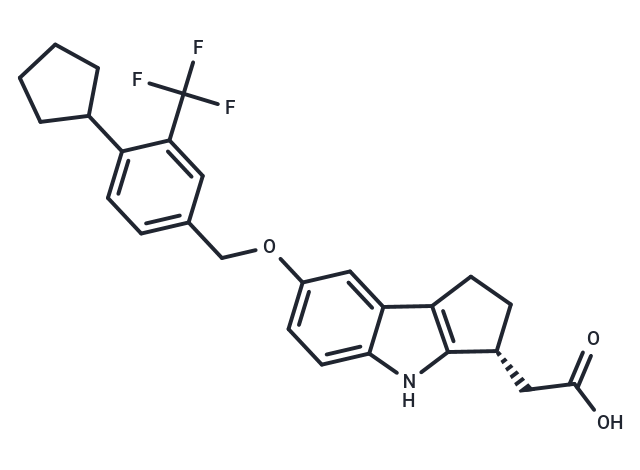Shopping Cart
- Remove All
 Your shopping cart is currently empty
Your shopping cart is currently empty

Etrasimod (APD334) is a specific and orally available antagonist of the sphingosine-1-phosphate-1 (S1P1) receptor (IC50: 1.88 nM in CHO cells).

| Pack Size | Price | Availability | Quantity |
|---|---|---|---|
| 1 mg | $48 | In Stock | |
| 5 mg | $113 | In Stock | |
| 10 mg | $189 | In Stock | |
| 25 mg | $255 | In Stock | |
| 50 mg | $322 | In Stock | |
| 100 mg | $446 | In Stock | |
| 1 mL x 10 mM (in DMSO) | $115 | In Stock |
| Description | Etrasimod (APD334) is a specific and orally available antagonist of the sphingosine-1-phosphate-1 (S1P1) receptor (IC50: 1.88 nM in CHO cells). |
| Targets&IC50 | S1P1:1.88 nM (CHO cells) |
| In vitro | In CHO cells expressing HA-tagged S1P1, APD334 is found to have an IC50 value of 1.88 nM. Moderate agonism at human S1P4 and S1P5 is observed but is reduced relative to S1P1, both in terms of potency and efficacy. APD334 is devoid of any agonism or antagonism at human S1P2 and S1P3. |
| In vivo | APD334 has a relatively low systemic clearance (<4% of hepatic blood flow) and high Cmax across all species. In both dog and monkey, a significant decrease in the volume of distribution (Vss) is observed relative to the rodent. Oral bioavailability is in the range of 40–100% and the terminal phase half-life varied from 6 h in monkey, to as long as 29 h in the dog. |
| Animal Research | APD334 induced effects on blood lymphopenia are determined in male Sprague-Dawley rats. Briefly, male rats are given a 0 (vehicle only), 0.03 (mice only), 0.1, 0.3 or 1 mg/kg oral dose of APD334 formulated in 0.5% methylcellulose (MC) in water. Rat blood samples are collected at 0, 1, 3, 5, 8, 16, 24, 32, 48 and 72 hours post-dose. APD334 induced effects on blood lymphopenia are determined in male BALB/c mice. Briefly, male mice are given a 0 (vehicle only), 0.03 (mice only), 0.1, 0.3 or 1 mg/kg oral dose of APD334 formulated in 0.5% methylcellulose (MC) in water. Mouse blood samples are taken at 0, 1, 3, 5, 8, 16, 24 and 32 hours post-dose. |
| Alias | APD334 |
| Molecular Weight | 457.48 |
| Formula | C26H26F3NO3 |
| Cas No. | 1206123-37-6 |
| Smiles | OC(=O)C[C@H]1CCc2c1[nH]c1ccc(OCc3ccc(C4CCCC4)c(c3)C(F)(F)F)cc21 |
| Relative Density. | 1.326 g/cm3 (Predicted) |
| Storage | Powder: -20°C for 3 years | In solvent: -80°C for 1 year | Shipping with blue ice. | ||||||||||||||||||||||||||||||
| Solubility Information | DMSO: 25 mg/mL (54.65 mM), Sonication is recommended. | ||||||||||||||||||||||||||||||
Solution Preparation Table | |||||||||||||||||||||||||||||||
DMSO
| |||||||||||||||||||||||||||||||

Copyright © 2015-2025 TargetMol Chemicals Inc. All Rights Reserved.